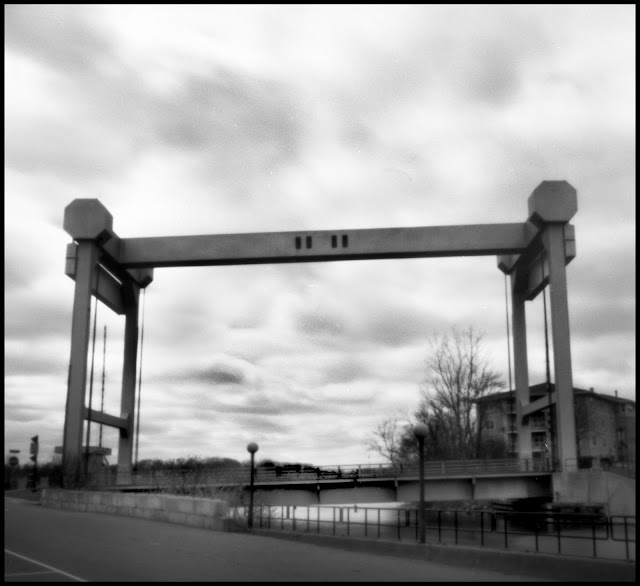Last Saturday, four gracious, cheerful and enthusiastic members of the Fox Valley Photography Meetup Group participated in a camera-making, photograph-taking workshop with me. I really learned a lot.
The main take-away is that I still need to reduce the time it takes to make a finished camera. The shutter channels, shutter slider, tripod mounts and winders had already been made up with the help of my former colleague-in-the-office-next-door Brian Ledwell, Laser Cutter Artiste Extraordinaire. We're now going to make all the parts that are not visible on the outside of the camera with the adhesive already applied and fold lines scored. Participants will still make the outside boxes and the shutters i.e. the fun part. One advantage is that with the premade parts, a shutter is just about as easy to make as just a flap over the counter hole. I noticed people fussing with the jury-rigged counter shutters just held under the rubber bands. The second proper shutter does make a more finished looking product. Also, the shutters are exactly the same size as the negative so they can help with viewfinding if you have one on the back.Another painful learning experience was discovering the need to make a jig to hold and guide the square punch for cutting the holes in the taking shutter. I smashed my fingertip with the mallet and bled all over my camera. It was on the inside of the shutter so you can't see it.
We just barely got the cameras made in four hours. The Kaukana Public Library, where we were meeting, closed at 1 pm so we had to be cleaned up and out by then. About noon I made the call that we didn't have time to make and measure pinholes and handed out ones I had drilled earlier in the week. I really want those kids this summer to drill their own pinhole.
Bobbi made a 30mm camera, Caroline chose 45mm, and Dave, Mike and I, 60mm. I decided to use the Zesta Saltine Cracker box because I read in a Facebook post the previous day that red was bold and daring.
Mike had to go play with his granddaughter after lunch (his phrasing). The rest of us decided to go back to the Libary with it's historic exterior, location on the rapids and locks of the Fox River, and proximity to the giant Thilmany Paper Mill. That might not have been the best choice. The library is located on an island in the river. It was 36° F with a 20 mile per hour sustained wind and no other places to go to warm up.
I've never participated in a group photo shoot before and didn't quite know what to do. I tried to stay close to give advice and help, but eventually we all drifted off to different parts of the island.
The most recognizable feature of downtown Kaukana is the Veterans Memorial Lift Bridge. The locks on the Fox River, built in the 1850s, have been restored for mostly pleasure-boat navigation between Lake Winnebago and Green Bay. Restoring this bridge to operation was one of the last things done. I was wishing I had a rising front but the sky was pretty interesting so I just tilted up. The bridge itself isn't perfectly square anyway–the right bank is a little higher than the left.
 I had given the participants a table of exposures. It was mounted on a black card they could use to wave away and back over the pinhole for short exposures, which you can see in use in the above photo.
I had given the participants a table of exposures. It was mounted on a black card they could use to wave away and back over the pinhole for short exposures, which you can see in use in the above photo.The new parts are already in production and I may try to get another group of volunteers to try them out, hopefully on a nicer day.
The Zesty Populist has a .30mm pinhole 60mm from a 6x6mm frame. The film is TMax 100 semi-stand developed in Rodinal 1:100.
Happy Worldwide Pinhole Photography Day, everyone!
















No comments:
Post a Comment